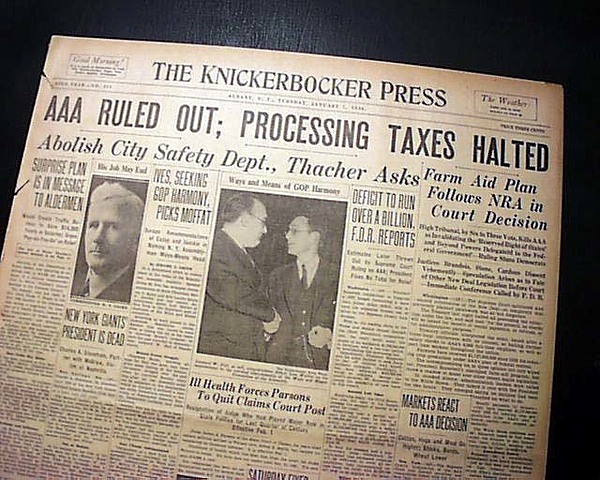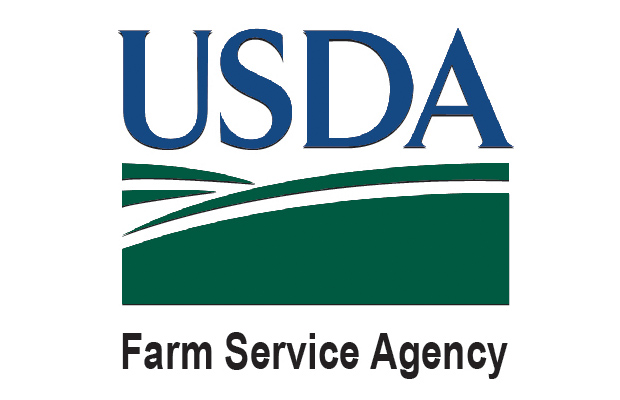In the previous Friday Footnote, we learned about the Agricultural Adjustment Act of 1933. We ended the Footnote with a Supreme Court ruling in 1936 that invalidated the Act. The Court ruled that a special tax paid by food processors to fund the Act was unconstitutional.

Figure 1: Agricultural Adjustment Act ruled unconstitutional.
So, what should President Roosevelt and Congress do? The response was to rewrite the Act and fix the problems. This Footnote focuses on the actions of the government after the Agricultural Adjustment Act of 1933 was nullified by the Supreme Court.
Plan B
The Supreme Court ruling declaring the 1933 Act unconstitutional was announced on January 6, 1936. Less than two months later (Feb. 29, 1936) the AAA resurfaced as part of the Soil Conservation and Domestic Allotment Act of 1936. This Act served two purposes – it amended the Soil Conservation Act that had been passed in 1935 (which primarily supported soil conservation demonstrations) and created a new plan for handling the overproduction of certain crops. In my opinion, combining the two acts was genius.
Instead of paying farmers NOT to grow certain crops where there was a surplus such as peanuts, tobacco, and cotton, this new act provided an incentive to take land out of crop production and apply soil improvement and conservation practices to the land. Farmers received payments for growing legumes and grasses on former cropland. This conserved the soil and reduced the acreage of certain crops. Farmers received payments to terrace fields, contour farm, apply lime plus other soil amendments, and establish mechanical erosion control practices. Nearly 53 million acres were taken out of crop production using this approach AND soil was conserved on the farms. The money to support the program came out of the U.S. Treasury, not from food processors.

Figure 2: An example of the results of the Soil Conservation and Domestic Allotment Act
Plan C
When President Roosevelt signed the original Agricultural Adjustment Act in 1933 he stated we are taking “a new and untrod path.” That was certainly true. That Act was ruled unconstitutional and was then combined with other legislation. Finally, after a five-year period of trial and error, President Roosevelt called the national agricultural leadership to a conference in Washington to develop a plan for the future of agriculture. Jointly, the national agricultural leadership in coordination with Congress developed the Agricultural Adjustment Act of 1938.
When President Roosevelt signed the Act on February 16, 1938 he stated:
The Agricultural Adjustment Act of 1938 represents the winning of one more battle for an underlying farm policy that will endure. Therefore it is historic legislation. It is not perfection, but it is the constructive product of the able and sincere work of many men. I believe the overwhelming majority of the people will commend members of Congress and others who have devoted themselves to the making of this law. As we go ahead under the new Act, let us resolve to make it an effective instrument to serve the welfare of agriculture and all our people.
Roosevelt’s words were prophetic. Today the 1938 Act is considered “permanent” legislation. Lipton and Pollack write (1996, p. 128):
The 1938 Act is considered part of permanent legislation. Provisions of this law are often superseded by more current legislation. However, if the current legislation expires and new legislation is not enacted, the law reverts back to the 1938 Act (along with the Agricultural Act of 1949).
The legality of the 1938 Act was challenged in the Wickard vs. Filburn case which reached the Supreme Court. The law was upheld as being constitutional.
The 1938 Act was designed “to provide for the conservation of natural soil resources and to provide an adequate and balanced flow of agricultural commodities in interstate and foreign commerce and for other purposes.” The Act contains five titles (sections):
- Title I – A continuation of the Soil Conservation and Domestic Allotment Act
- Title II – Authorized the Secretary of Agriculture to work with the Commerce Commission regarding freight rates on agricultural commodities, established four regional research laboratories to find new uses and new markets for agricultural commodities, and continued the distribution of surplus agricultural commodities for relief purposes.
- Title III – Created price supports (based on the concept of parity) for selected agricultural commodities and established marketing quotas for certain agricultural products to keep the supply in line with market demand. Also established a loan program.
- Title IV -Cotton Pool Participation Trust Certificates
- Title V – Established the Federal Crop Insurance Corporation (FCIC)
The law was 46 pages in length and Title III contained numerous subsections addressing specific crops. If you want to read the Act it can be found at https://nationalaglawcenter.org/wp-content/uploads/assets/farmbills/1938.pdf. Numerous agricultural acts have been enacted since 1938, however, the precedents established by this legislation still influence agricultural policy today.

Figure 3: An AAA representative in his New Mexico office in 1941. Note the conservation emphasis. Image from Irving Rusinow, Photographer (NARA record: 5307166) – U.S. National Archives and Records Administration, Public Domain, https://commons.wikimedia.org/w/index.php?curid=17221315
What’s in a Name?
The administrative mechanism for implementing the Agricultural Adjustment Act is still in place today. However, over time, the name of the government group responsible for implementing these agricultural policies has changed several times.
Following is a listing of the various names and agencies within the USDA from 1933 until today:
- Agricultural Adjustment Administration (1933-42)
- Agricultural Adjustment Agency, Agricultural Conservation and Adjustment Administration (1942)
- Agricultural Adjustment Agency, Food Production Administration (1942-43)
- Agricultural Adjustment Agency, Administration of Food Production and Distribution (1943)
- Agricultural Adjustment Agency, War Food Administration (1943-45)
- Production and Marketing Administration (PMA, 1945-53)
- Commodity Stabilization Service (CSS, 1953-61)
- Agricultural Stabilization and Conservation Service (1961-94)
- Consolidated Farm Service Agency (1994-today)
The various names can be confusing and hard to keep up with. In the summers of 1967 and 1968 I was an intern with the USDA Soil Conservation Service (SCS) in Gatesville, Texas. The Extension Service offices were in the same building as the SCS along with the Agricultural Stabilization and Conservation Service (ASCS). Since two of the groups had “Conservation Service” as part of their name, this led to confusion.
I finally figured out a way to explain which office was which to people who inquired. The Soil Conservation Service worked with farmers to establish soil and water conservation plans and we provided technical expertise to design farm ponds, terraces, waterways, and other conservation structures. If the farmer needed financial assistance to implement our plans, then they would go down the hall to the ASCS office because this group had the money. The ASCS office handled crop quotas, crop subsidies, government farm payments, and other financially related matters.

Figure 4: The Farm Service Agency of today is a descendent of the Agricultural Adjustment Administration
The Farm Service Agency (FSA) replaced the ASCS in 1994 and remains in operation today. In 1994 the functions of the Farmers Home Administration were placed in the FSA portfolio. The list below includes the current services provided by the FSA. If you are not familiar with some of the programs or acronyms, you might want to check them out. They do have a youth loan program for 4-H and FFA members. They also have a loan program for Minority and Women Farmers and Ranchers. FSA Services include:
- Aerial Photography
- ARC/PLC Program
- Commodity Operations
- Conservation Programs
- Cooperative Agreements
- Cotton Ginning Cost Share Program
- Dairy Margin Protection Program
- Disaster Assistance Programs
- Economic and Policy Analysis
- Energy Programs
- Environmental and Cultural Resource Compliance
- Farm Bill
- Farm Loan Programs
- Financial Management Information
- Laws and Regulations
- MIDAS
- Outreach and Education
- Payment Eligibility
- Price Support
Concluding Remarks
Many years ago, a graduate student wrote a Master’s thesis about the importance of agriculture teachers working with the extension service and other agricultural groups. When asked to identify the local extension agent, this student was not able to do so. Talk about embarrassing!
You don’t want something like this to happen to you. As an agricultural leader in your community, you really do need to know and work with groups like the Extension Service, the Natural Resources Conservation Service, Farm Credit, the Farm Service Agency, plus others. If you have not visited your local Farm Service Agency please consider doing so. You might consider having a representative speak to a class or FFA Meeting.

Figure 5: The goal of U.S. Farm Policies (image from the Alicia Patterson Foundation)
References
F. F. R. (1938). The Agricultural Adjustment Act of 1938. Virginia Law Review, 24(8), 914-919. doi:10.2307/1068087
Lipton, Kathryn & Pollack, Susan (1996). Major Agriculture and Trade Legislation, 1933-1996. In Appendix III of Provisions of the Federal Agricultural Improvement and Reform Act of 1996. https://www.ers.usda.gov/publications/pub-details/?pubid=42097
Roosevelt, Franklin D. (1938). Statement on Signing the Agricultural Adjust Act of 1938. https://www.presidency.ucsb.edu/documents/statement-signing-the-agricultural-adjustment-act-1938
